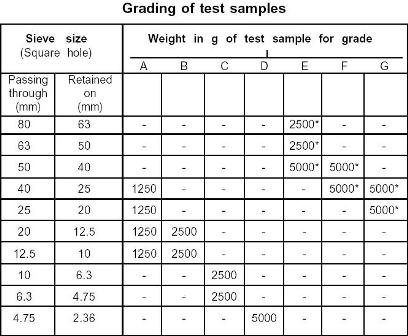Los Angeles Abrasion Test for Aggregate
Abrasion test is carried out to test the hardness property of aggregates and to decide whether they are suitable for the pavement or not.The principle of Los Angeles abrasion test is to find the percentage wear due to relative rubbing action between the aggregate and steel balls used as per code IS:2386 (Part IV)-1963.
Apparatus
The test sample consists of clean aggregates dried in oven at 105° – 110°C, Los Angeles Machine, Abrasive charge: Cast iron or steel balls, approximately 48mm in diameter and each weighing between 390 to 445 six to twelve balls are required, Balance of capacity 5 kg or 10 kg, Sieve: 1.70, 2.36, 4.75, 6.3, 10, 12.5, 20, 25, 40, 50, 63, 80 mm IS Sieves. Drying oven,tray.
Procedure
- Select the grading to be used in the test such that it conforms to the grading to be used in construction, to the maximum extent possible.Take 5 kg of sample for grading A, B, C & D and 10 kg for grading E, F & G as shown in Table . Table : Number of Spheres as per Gradation of Aggregate.
- Choose the abrasive charge as per Table depending on grading of aggregates.
- Place the aggregates (weighed W1) and abrasive charge on the cylinder and fix the cover.
- Rotate the machine at a speed of 30 to 33 revolutions per minute. The number of revolutions is 500 for grading A, B, C & D and 1000 for gradings E, F & G.
- The machine is stopped after the desired number of revolutions and material is discharged to a tray.
- The entire stone dust is sieved on 1.70 mm IS sieve. 8. The material coarser than 1.7mm size is weighed (W2) correct to one gram.
 |
| Gradation vs number of spheres of abrasive charge |
Calculation:
Original weight of aggregate sample = W1 g
Weight of aggregate sample retained = W2 g
Weight passing 1.7mm IS sieve = W1 – W2 g
Abrasion Value = (W1 – W2 ) / W1 X 100
 |
| Abrasion Value and Suitability for types of pavement |




No comments:
Post a Comment